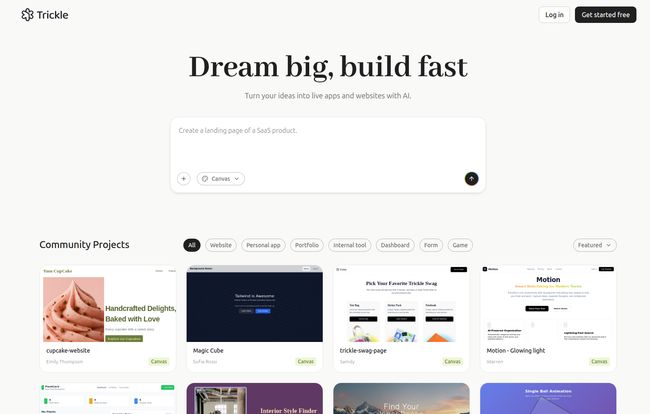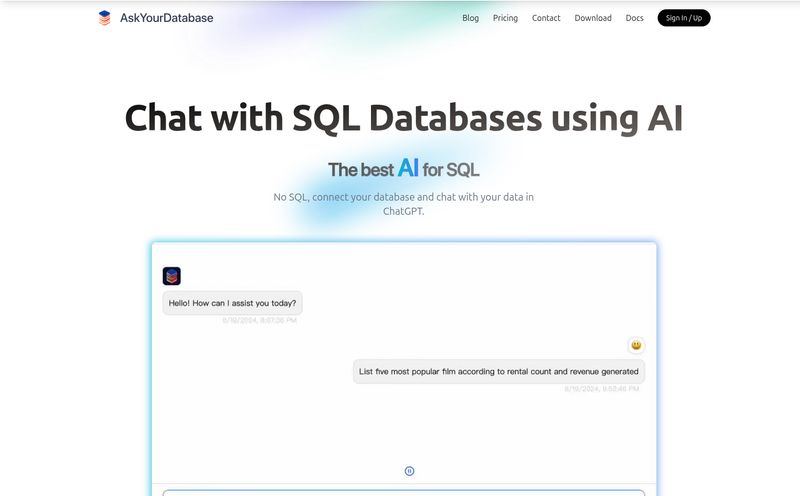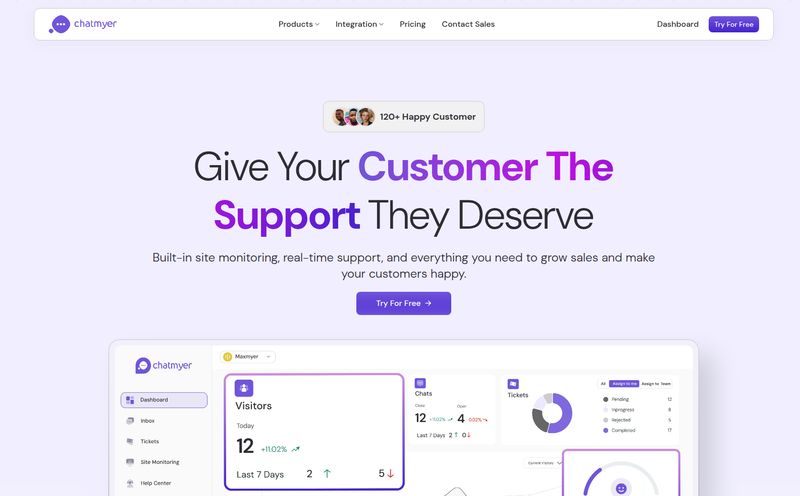How many of you have a graveyard of brilliant side-project ideas? You know the ones. The little tools, the niche marketplaces, the hyper-specific calculators. Ideas that could have been something, but died a quiet death the moment you thought about spinning up a server, wrestling with a database, or even just figuring out how to connect a front-end form to… well, anything.
I’ve been in the SEO and digital marketing game for years, and my own project graveyard is vast and spooky. The technical overhead for even a “simple” idea can be a total passion killer. So when I see a tool that claims you can turn ideas into live apps and websites with AI, just by describing what you want… my cynical veteran-of-the-internet-wars eyebrow goes way up. But my curious inner-nerd starts paying very close attention.
The tool is called Trickle, and it’s been making some waves. Their tagline is basically “Your words, your apps.” It’s a bold claim. So I decided to kick the tires, pop the hood, and see if this thing is actually the real deal or just another shiny object in the ever-expanding universe of AI tools.
So, What Exactly Is Trickle?
Let's get this straight first: Trickle isn't just another drag-and-drop website builder like Squarespace or Wix. And it’s not quite a full-blown no-code platform like Bubble, which can feel like learning a new programming language in itself. Trickle is something different.
Think of it as an integrated creation studio. It wants to be the single place you go to dream up an idea, describe it to an AI, and have a functional web app pop out the other side—complete with a built-in database, hosting, and analytics. It’s less like a box of LEGOs and more like a 3D printer for web apps. You give it the blueprint (your words), and it handles the messy business of actually building the thing.
This all-in-one approach is what first caught my eye. The idea of not having to duct-tape five different services together to launch a simple project is, frankly, a dream.
My First Spin: A Quick Walkthrough
Signing up is simple, and you're dropped right into a clean, minimalist dashboard. The main event is a prompt box, beckoning you with the simple challenge: “Create a landing page of a SaaS product.” or whatever else you can dream up.
I started with something simple. “Create a website to showcase handcrafted cupcakes, with a gallery and a contact form.”
And… it worked. In a few moments, I had a surprisingly good-looking starting point. A hero section, a nice photo gallery, and a form that—and this is the important part—was already wired up to a database. I could see submissions right there in the Trickle interface. No Zapier integrations, no third-party form handlers. It just… worked.
The community projects section is a rabbit hole of inspiration. You see everything from internal tools and pet-store websites to portfolio pages and little games. It’s a powerful proof-of-concept, showing the sheer variety of what the platform is capable of.

Visit Trickle AI
The Features That Actually Matter
Lots of tools boast about features, but only a few really change your workflow. Here's what stood out to me in Trickle.
The Magic of AI-Powered Creation
This is the core of Trickle. You’re not just picking a template; you're co-creating with an AI. You can say things like, “Add a section with three pricing tiers,” or “Change the color scheme to be more earthy and warm.” It’s a conversation. It doesn't always get it perfect on the first try, of course, but the iteration process is incredibly fast. It feels less like coding and more like directing a very capable, very literal assistant.
A Built-in Database That Doesn't Suck
For me, this is a huge deal. The moment a project needs to store information—user sign-ups, form submissions, product listings—the complexity skyrockets. Trickle comes with a simple, spreadsheet-like database built right in. When the AI builds a form for you, it automatically creates the database table and connects everything. This single feature probably cuts development time for small projects by 80%.
Painless Hosting and Deployment
Once you’re happy with your creation, you just… deploy it. It’s hosted. It’s live. On the paid plans, you can easily connect a custom domain. This removes that final, often frustrating, hurdle between having a finished project and sharing it with the world. No FTP, no server management, just a button.
Who Is This Really For?
After playing around for a while, I have a pretty clear idea of who needs to check out Trickle immediately.
- Solopreneurs & Indie Hackers: If you have a dozen ideas a week, this is your new best friend. It’s perfect for rapidly building MVPs (Minimum Viable Products) to test market demand without sinking weeks into development.
- Marketers & SEOs: Need a quick landing page for a campaign? A simple tool to generate leads? A microsite for a specific keyword? You can build these yourself in an afternoon without needing to bother the dev team. This is huge for agility.
- Designers & Creatives: You can build a stunning portfolio or a site for a client project and make it functional without writing a single line of code.
Who isn't it for? Probably not for a large, complex enterprise platform that needs intricate backend logic and scalability for millions of users. It's not trying to replace a team of senior developers building the next Facebook. It's aiming to empower everyone else, and I think it succeeds.
Let's Talk Money: Trickle Pricing Explained
Alright, the all-important question: what’s this going to cost? The pricing structure seems pretty fair and is designed to scale with you. They have a free tier that’s genuinely useful for testing the waters.
Here’s a quick breakdown as of late 2023. Keep in mind that software pricing can change, so always check their official pricing page for the latest info.
| Plan | Monthly Price | Key Features |
|---|---|---|
| Free | $0 | 5 messages/day (up to 30/mo), 100 database rows, hosting, 3 projects. Great for trying it out. |
| Pro | ~$20/month | 120 messages/mo, 1,000 database rows, custom domain support, unlimited projects, no Trickle badge. |
| Premium | ~$50/month | 300 messages/mo, 10,000 database rows, more domains, and all Pro features. |
Note: They offer a discount for annual billing, which is where you might see slightly different monthly rates advertised. The Pro plan for instance often shows as $17/mo if you pay for the whole year upfront.
The Good, The Bad, and The AI-Generated
No tool is perfect. After my time with Trickle, here’s my honest breakdown.
What I Love
I’ve gotta admit, the all-in-one promise is delivered. The sheer speed from idea to live, functional app is its killer feature. The integration of the AI prompt, the builder, the database, and the hosting is seamless. It removes so much friction from the creative process. It genuinely feels a little bit like magic.
Where It Could Improve
The free plan is a great taste, but the message limits are pretty tight. You’ll burn through them quickly if you're doing a lot of iteration. Also, by design, you're building on their platform. You can't just export the code and host it somewhere else. This platform lock-in is common with builders like this, but it's something to be aware of. You're committing to their ecosystem.
Frequently Asked Questions about Trickle
- Is Trickle easy for total beginners?
- Absolutely. If you can write an email, you can use Trickle. It's one of the most beginner-friendly app creation tools I've ever seen because it sidesteps a lot of the technical jargon.
- Can I use my own custom domain?
- Yes, you can. Custom domain support is included in the Pro and Premium plans. The free plan will give you a `trickle.host` subdomain.
- How does Trickle compare to something like Webflow or Bubble?
- It's a different beast. Webflow is for designers who want granular control over the visuals. Bubble is for building highly complex applications without code, but has a steep learning curve. Trickle is for speed and simplicity, using AI as the primary building interface. It’s for getting a functional v1.0 out the door, fast.
- What kind of AI models does it use?
- The platform mentions using 'Basic AI models'. This most likely refers to powerful Large Language Models (LLMs), similar to the technology behind tools like ChatGPT, which are trained to understand and generate human-like text and, in this case, code and web structures.
- Is the free plan actually useful or just a demo?
- It's useful for building one or two very small projects and for getting a complete feel for the platform's capabilities. You can build and launch a real, live site on it. You'll just hit the usage limits pretty quickly if you're building something bigger or iterating a lot.
My Final Verdict: Is Trickle the Future?
I came in skeptical, and I'm leaving impressed. Trickle isn't going to put all software developers out of a job tomorrow. But it represents a significant shift in who can build things for the web. It's a massive democratizing force.
For years, the barrier to creation wasn't the idea, it was the execution. Trickle lowers that barrier almost to the ground. It turns the conversation from “How could I possibly build this?” to “What should I build next?” And for a guy with a project graveyard full of ghosts, that’s a very exciting change indeed. It might just be time for a resurrection.



